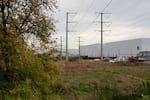Demand for electricity in the Northwest could double by 2046, according to a new energy forecast from regional experts.
Over the next two decades, demand could increase by between 1.8% and 3.1% annually, the Northwest Power and Conservation Council heard Tuesday. The projected growth will come primarily from companies building more data centers in the region, more electric vehicles on roads, electrifying buildings, computer chip manufacturing and the production of “green hydrogen” created by running an electrical current through water to split the molecules into hydrogen and oxygen.

QTS Data Centers Hillsboro 3 Data Center in Hillsboro, OR, October 11, 2024. Electricity demand in the Northwest could double in next 20 years, forecast finds.
Rian Dundon / Rian Dundon
Council staff presented the 20-year forecast for electricity demand in Oregon, Washington, Idaho and western Montana Tuesday to the council’s eight, governor-appointed members. Each state’s governor gets to appoint two representatives.
“The data centers, naturally in our forecasts, are the very early load growth driver here. They’re the big driver of near term demand,” Steven Simmons, senior energy forecasting analyst, told the council. Energy demand from data centers and from all electric vehicles in the region are expected to be equal by 2046, and demand from EVs is likely to surpass data center demand after 2046, Simmons said.
Residential and commercial demand, which includes forecasted energy demand for electric vehicle charging at homes and buildings, but does not include data centers, is expected to grow more gradually. Demand for residential and commercial energy in Washington alone will equal the combined demand from those sectors in Oregon, Idaho and Montana during the next two decades.
The energy forecast, part of the council’s forthcoming 9th Northwest Regional Power Plan to manage demand, does not yet include some possible variables that could reduce future demand, such as improved energy efficiency in cars, buildings and some industries as a response to demand, as well as growing adoption of rooftop solar on residential and commercial buildings.
But rapidly growing demand now means electricity grids in the Northwest and across the U.S. are encountering transmission constraints, and scaling infrastructure to meet demand has been slow due to supply chain delays and issues, staff said.
Data centers
Council staff expect the biggest growth in data center and computer chip energy demand will occur in eastern Oregon, eastern Washington, and the Portland and Boise metro areas, based on historical trends and announced projects.
There are more than 100 data centers in Oregon, according to the company Data Center Map, and there are more than 5,000 data centers throughout the U.S. according to Statista — the most in any country.
Oregon’s data center market is the fifth largest in the nation, according to Chicago-based commercial real estate group Cushman & Wakefield. Amazon, Apple, Facebook, Google and X, formerly named Twitter, have massive data centers in eastern Oregon as well as in The Dalles, Hillsboro and Prineville.
What’s next
To develop its next power plan, the council will evaluate supply side resources, including the potential for more regional windfarms, utility-scale and small-scale solar installations, better battery storage and more geothermal and fracked gas sources, among other options.
The council has published regional power plans about every five years since 1983, to lay out how the region will maintain an affordable and adequate power supply. A draft of the plan, an update from the last one that was published in 2021, is expected to be ready for public review and input by July 2026 and would be finalized by late 2026, according to council spokesperson Peter Jensen.
The Northwest Power and Conservation Council was formed in 1981 following passage of the federal Northwest Power Act. That act directed the four states to work collaboratively on regional energy planning and to stop the decline of native Columbia Basin fish species that have suffered massive population losses over the last century, primarily from the development of hydroelectric dams in the region.
Oregon Gov. Tina Kotek in February appointed two new Oregon representatives to the council: Margaret Hoffmann, of Bend, and Chuck Sams, of Pendleton. Hoffman is the former Oregon director of the U.S. Department of Agriculture’s Rural Development program and energy adviser to former Oregon Govs. John Kitzhaber and Kate Brown.
Sams, former executive director of the Confederated Tribes of the Umatilla Indian Reservation, was most recently director of the National Park Service. Sams briefly served on the council in 2021 before he was appointed to run the Park Service.
Oregon Capital Chronicle is part of States Newsroom, a network of news bureaus supported by grants and a coalition of donors as a 501(c)(3) public charity. Oregon Capital Chronicle maintains editorial independence. Contact Editor Julia Shumway for questions: info@oregoncapitalchronicle.com. Follow Oregon Capital Chronicle on Facebook and X.
This republished story is part of OPB’s broader effort to ensure that everyone in our region has access to quality journalism that informs, entertains and enriches their lives. To learn more, visit opb.org/partnerships.